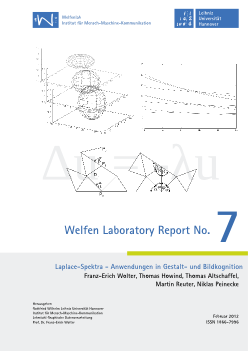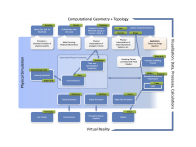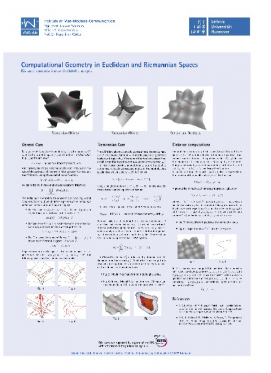Publikationen
Welfenlab Reports
Durch unsere Veröffentlichungsreihe Welfen Laboratory Reports informieren wir über Forschungsarbeiten an unserem Lehrstuhl, unter anderem werden auf diesem Weg ausgewählte studentische Abschlussarbeiten publiziert.
Publikationen nach Jahren
Hier finden sie sämtliche Publikationen des Welfenlab geordnet nach Art der Publikation und Erscheinungsdatum.
Sie finden hier auch ein vollständige Publikationsliste.
| 1979 . . . 2009 | 2010 | 2011 | 2012 | 2013 | 2014 | 2015 | 2016 |
2012
| Artikel |
| 2012 |
Tine Thiessen, Martin Gutschke, Philipp Blanke, Wolfgang Mathis, Franz-Erich Wolter Differential Geometric Methods for Jump Effects in Nonlinear Circuits In Nonlinear Dynamics of Electronic Systems, Proceedings of NDES 2012. VDE. pp. 1-5 2012 Beschreibungstext anzeigen We present efficient algorithms for the simulation of problematic circuits with fast switching behavior based on the idea of tracing significant sets on the state space manifold. The switching behavior is represented by “jumps” from one part of the manifold to another. Our approach makes a regularization of the circuit unnecessary. In this article, we extend our approach to circuits with higher codimensions and jump spaces and verify the functionality by the application to a simple MOS flip flop. Furthermore, we show how to visualize the phenomena by using a special projection. Beschreibungstext verbergen |
Benjamin Fleischer, Karl-Ingo Friese, Franz-Erich Wolter, Gavin Olender, Christoph Becher and Christoph Hurschler Automatic evaluation of human knee joint kinematics based on MRI images J. Comp. Anim. and Virtual Worlds, Proc. CASA 2012 Wiley 2012 |
Matthias Becker, Karl-Ingo Friese, Franz-Erich Wolter, Nils-Claudius Gellrich and Harald Essig Development of a Reliable Method for Orbit Segmentation & Measuring J. Comp. Anim. and Virtual Worlds, Proc. CASA 2012 Wiley 2012 |
Hannes Thielhelm, Alexander Vais, Daniel Brandes, Franz-Erich Wolter Connecting geodesics on smooth surfaces THE VISUAL COMPUTER Springer 2012 Beschreibungstext anzeigen In this paper, we present a novel method for computing multiple geodesic connections between two arbitrary points on a smooth surface. Our method is based on a homotopy approach that is able to capture the ambiguity of geodesic connections in the presence of positive Gaussian curvature that generates focal curves. Contrary to previous approaches, we exploit focal curves to gain theoretical insights on the number of connecting geodesics and a practical algorithm for collecting these. We consider our method as a contribution to the contemporary debate regarding the calculation of distances in general situations, applying continuous concepts of classical differential geometry which are not immediately transferable in purely discrete settings. |
Alexander Vais, Benjamin Berger, Franz-Erich Wolter Spectral computations on nontrivial line bundles Computers & Graphics 36 398 - 409 Elsevier 2012 Beschreibungstext anzeigen Computing the spectral decomposition of the Laplace–Beltrami operator on a manifold M has proven useful for applications such as shape retrieval and geometry processing. The standard operator acts on scalar functions which can be identified with sections of the trivial line bundle M ×R. In this work we propose to extend the discussion to Laplacians on nontrivial real line bundles. These line bundles are in one-to-one correspondence with elements of the first cohomology group of the manifold with Z2 coefficients. While we focus on the case of two-dimensional closed surfaces, we show that our method also applies to surfaces with boundaries. |
| Beiträge in Tagungsbänden |
| 2012 |
Roman Vlasov, Karl-Ingo Friese, Franz-Erich Wolter Ray casting for collision detection in haptic rendering of volume data 2012 Beschreibungstext anzeigen A haptic exploration adds an additional dimension to working with 3D data: a sense of touch. This is especially useful in areas such as medical training and pre-surgical planning, entertainment, CAD and others. Each haptic rendering frame consists of three stages: collision detection, collision response and force- feedback generation. In order to feel the 3D data smoothly, an update rate of at least 1 kHz is required [Brooks Jr. et al. 1990]. Unaddressed practical problems for almost all haptic rendering methods are that no guarantees for collision detection could be given and/or that a special topological structure of objects is required. Here we present an approach which does not have these drawbacks. Furthermore our algorithm has nearly constant time complexity independent of data resolution and does not require any additional pre-computed structures. We focus on volumetric voxel data, since that is the direct input from the scanning devices. Other data types could be transformed to this one, if necessary. Beschreibungstext verbergen |
Roman Vlasov, Karl-Ingo Friese, Franz-Erich Wolter Haptic rendering of volume data with collision determination guarantee using ray casting and implicit surface representation 2012 Beschreibungstext anzeigen Haptic exploration adds an additional dimension to working with 3D data: a sense of touch. This is especially useful in areas such as medical simulation, training and pre-surgical planning, as well as in museum display, sculpting, CAD, military applications, assistive technology for blind and visually impaired, entertainment and others. There exist different surface- and voxel-based haptic rendering methods. Unaddressed practical problems for almost all of them are that no guarantees for collision detection could be given and/or that a special topological structure of objects is required. Here we present a novel and robust approach based on employing the ray casting technique to collision detection, which does not have the aforementioned drawbacks while guaranteeing nearly constant time complexity independent of data resolution. This is especially important for such delicate procedures as pre-operation planning. A collision response in the presented prototype system is rigid and operates on voxel data, and no precalculation is needed. Additionally, our collision response uses an implicit surface representation "on the fly", which can be used with dynamically changing objects. Beschreibungstext verbergen |
Felix Haase, Maximilian Klein, Andreas Tarnowsky, Franz-Erich Wolter Interactive Fractal Compositions 2012 Beschreibungstext anzeigen With the ever rising quality and complexity standards in computer graphics, the generation of detailed content has become a bottleneck. While high quality visualization can be achieved at comparatively low cost, content generation remains a labor intensive and expensive task. Procedural approaches can support this process by automating parts of it.
One common problem of procedural methods is that the variables controlling the result are difficult to adjust. Especially fractals may have unintuitive parameters, which make them difficult to handle in praxis.
In this paper we introduce the concept of a Region Tree to structure the workflow with these procedures and present a supporting framework. On top of this we show how we used GPU integration to make interactive editing possible.
With this approach it is easy to construct any number of procedural models from a set of user defined characteristics. We illustrate our method by creating an earth-like complex planet completely procedurally. Beschreibungstext verbergen |
Tina Thiessen, Martin Gutschke, Philipp Blanke, Wolfgang Mathis, Franz-Erich Wolter Differential Geometric Methods for Jump Effects in MOS Circuits 2012 |
| Verschiedene |
| 2012 |
Wolter, Rzepecki, Millan, Friese Visualization and Understanding of Medical and Scientific Data 2012 |






